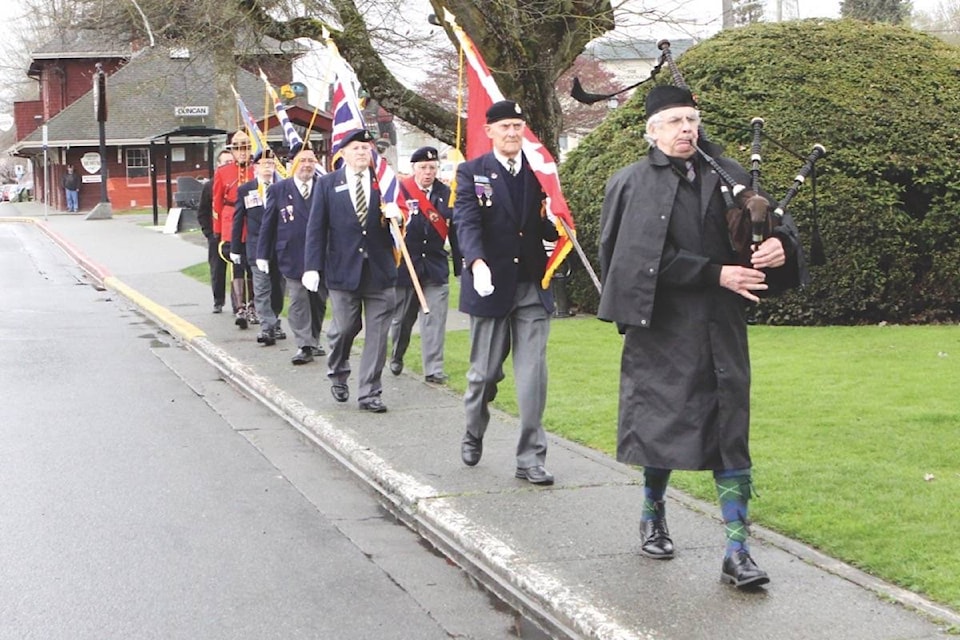A week later, the Cowichan Leader predicted, “their deeds will live as long as world endures…”
By now everyone who follows the news has seen, read or heard reports of the spectacular ceremonies honouring the 100th anniversary of the Battle of Vimy Ridge, which began on April 9, 1917.
News commentators have made much of its significance to Canada’s evolution from colony to nationhood, terming this victorious battle, the first of the First World War to be both conducted and fought independently by Canadian troops, as the beginning of Canada’s “coming of age”.
Although not of great strategic consequence in itself, Vimy Ridge has attained mythic symbolic significance for generations of Canadians as has the great memorial that today marks the site where 10,600 Canadian soldiers were killed or wounded in its capture.
So: Bearing in mind that the Cowichan Valley had the highest enlistment per capita for all of Canada, 1914-1918, what did the folks at home, who perhaps had husbands, sons or brothers at Vimy, think of this momentous event?
Firstly, we must understand that all military news was rigorously censored. Secondly, that there was always a slight delay (so unlike today’s newscasting). Thirdly, that the Cowichan Leader published weekly. Other than telegraph reports, which were received daily at the downtown Duncan railway station and posted publicly, Valley residents seeking to learn more about ‘outside’ news such as world events subscribed to either of the two Victoria dailies or the Nanaimo Free Press.
That said, the first issue of the Leader to be published subsequent to the battle was on April 12. Vimy Ridge didn’t make the front page. In fact, the only war news on page 1 was a single paragraph at the bottom. Under the heading, ‘Roll of Honour,’ it reported that Pte. Clement Arthur ‘Clem’ Thorpe of Duncan had been wounded in the chest and thigh by shrapnel at the Somme, two weeks before. He’d just returned to his pioneering unit after recovering from rheumatism when he was wounded.
The rest of the news was purely local. The publishers of the Victoria Times and Colonist had both taken up farms in Cobble Hill. The Duncan School Board had a new chairman. The province had appointed a new supervisor of Valley roads; the Duncan Ladies trounced their Chemainus basketball opponents, 10-4; opposition to commercial netting of spring, tyee and coho salmon in the Cowichan and Koksilah Rivers prompted a petition to be presented to Parliament. Dr. W. Dykes addressed the Cowichan Women’s Institute about public health and it was reported that 200 residents of Cobble Hill and region attended an Easter concert in aid of the King’s Daughters Hospital.
The first reference to Vimy Ridge, a name previously unknown to most Canadians, appeared in a short editorial a week later when the Leader proudly noted that “all four of the Canadian divisions were engaged in the glorious taking of Vimy Ridge”. Already the Duncan newspaper was predicting that “their deeds will live as long as the world endures…” But there was more work to be done, more casualties to be endured, and the editor urged citizens, while sharing in the glow of victory at Vimy, to support the Red Cross with more money and more volunteer efforts.
In a letter from France an unidentified Cowichan soldier raved, “I tell you I am proud to call myself a Canadian. The boys are wonderful. They go into a charge with a cheer, repulse the foe with determination and endure hardships and privations with determination…”
In following days and weeks the real cost of Vimy Ridge began to make itself known to those whose loved ones were involved in the fighting. One of the dreaded telegrams informed that Lt. R.H. Finlayson, who’d lost his left foot in the fighting, had died of blood poisoning. He wasn’t alone. Pte. Hugh Lipscomb, 36, formerly with the Cowichan Creamery and a noted athlete, left a widow and two children aged four and one years.
Pte. J.A. Struthers, 25, of Sahtlam, had also died of his wounds and two Duncan residents had suffered the loss of a brother each. Mrs. B.A. McMillan of Cobble Hill, who’d already lost one brother, L/Cpl. John Fraser at the Somme, now suffered the loss of brother Pte. Murdo Fraser. Wounded at Vimy but alive was J.G. Anderson, MC, formerly a Duncan schoolteacher, as was Koksilah’s Pte. Mordecai Garner, Canadian Pioneers.
Not so Cpl. Hamish K. Maitland-Dougall who’d died of wounds received at Vimy Ridge. A letter to his mother from his superior officers told how young Pte. G.M. ‘Jock’ Henderson’s comrades carried his body for almost five miles so that he could be buried in a military cemetery and have a chaplain-led service. He’d been the life and soul of C Company, “Always ready and willing to do a man’s work though he was just a lad in years.”
The names continued to trickle in: Pte. Archibald Macdonald, Koksilah, and former Shawnigan Lake logger Henry John Gardner. Reported as missing two months later was Sgt. Fred Douglas, Royal Canadian Regiment and formerly a harnessmaker in Duncan.
For the Allies, Vimy Ridge was a morale-building victory. For the Canadian nation, a seminal moment on the road to nationhood. For the families and friends of the men cited above, grief. For the men themselves, immortality of sorts and graves in a foreign land.
www.twpaterson.com
